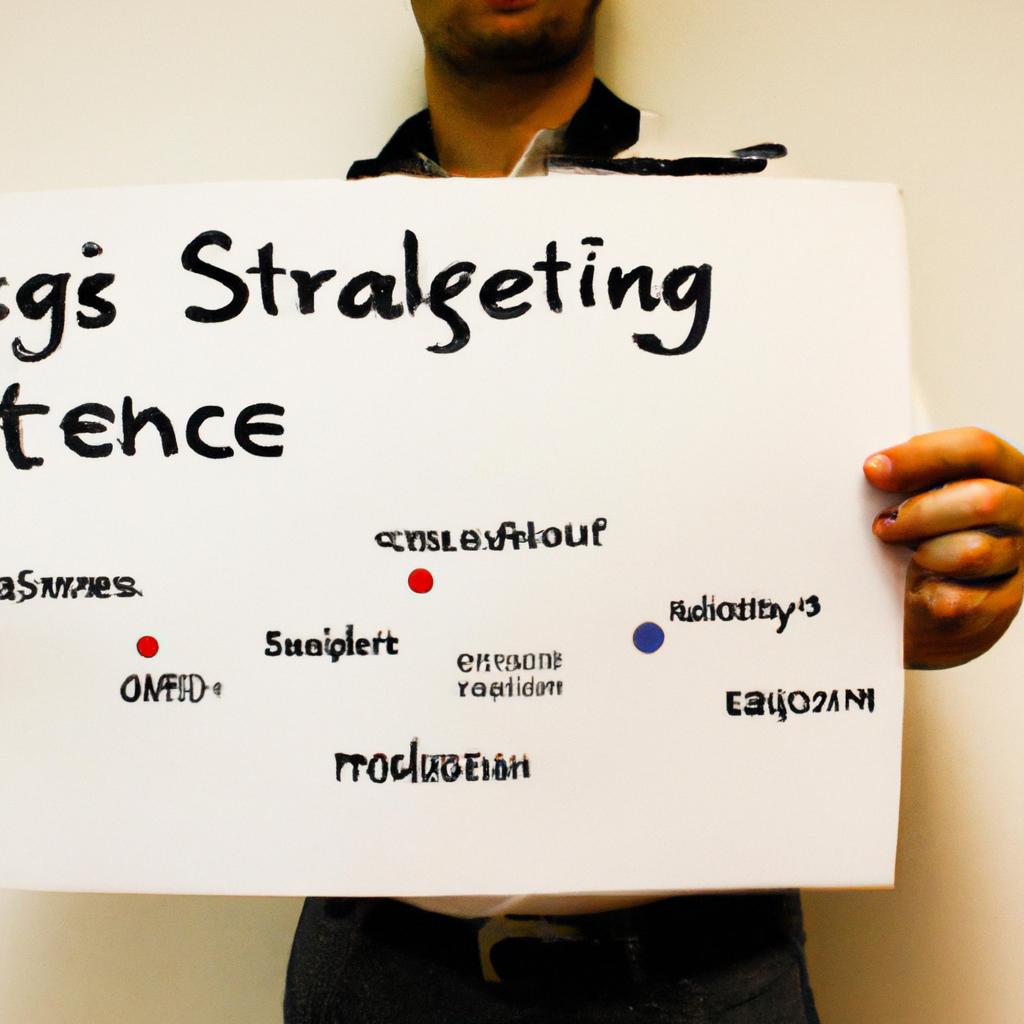Email marketing has emerged as a crucial tool in contemporary marketing and advertising strategies. With its wide reach, cost-effectiveness, and ability to target specific audiences, email marketing offers businesses an effective means of promoting their products or services. This article aims to explore the various promotional strategies that can be employed through email marketing, highlighting their advantages and potential challenges.
For instance, consider the case of Company X, a startup fashion brand seeking to establish itself in a highly competitive market. By utilizing email marketing techniques, such as personalized product recommendations based on customer preferences and behavior analysis, Company X was able to effectively engage with its target audience and generate higher conversion rates. Additionally, by implementing automated drip campaigns tailored to different stages of the customer journey, Company X successfully nurtured leads into loyal customers over time. These results demonstrate the potential effectiveness of email marketing for businesses aiming to create impactful promotional strategies.
In this context, it is essential to examine the key elements of successful email marketing campaigns while considering ethical considerations associated with data protection and privacy regulations. Furthermore, understanding how to craft compelling content that resonates with recipients’ needs and desires plays a pivotal role in achieving campaign objectives. By delving into these aspects and discussing best practices within the realm of email marketing promotion strategies, this article aims to provide businesses with actionable insights and guidelines for leveraging email marketing to drive their promotional efforts.
One important element of successful email marketing campaigns is building a targeted and segmented subscriber list. By understanding the unique characteristics and preferences of different customer segments, businesses can tailor their email content and offers accordingly, increasing the likelihood of engagement and conversion. This requires implementing effective lead generation strategies to attract quality subscribers who are genuinely interested in the products or services being offered.
Crafting compelling content is another vital aspect of successful email marketing promotion. The content should be valuable, relevant, and engaging to capture the attention of recipients. It’s crucial to understand the pain points, desires, and motivations of the target audience to create content that resonates with them. Incorporating storytelling techniques, personalization, and persuasive language can help make emails more compelling and increase their effectiveness in driving desired actions.
Automation plays a significant role in optimizing promotional strategies through email marketing. Automated drip campaigns allow businesses to nurture leads by sending a series of timed emails tailored to specific stages of the customer journey. This approach enables consistent communication with prospects while providing relevant information and incentives at each stage, ultimately guiding them towards making a purchase decision.
However, it is essential for businesses to consider ethical considerations associated with data protection and privacy regulations when conducting email marketing campaigns. Compliance with laws such as GDPR (General Data Protection Regulation) ensures that subscriber data is collected, stored, and used responsibly. Implementing transparent opt-in processes, providing clear privacy policies, and allowing easy unsubscribe options are some practices that demonstrate respect for subscribers’ privacy rights.
In conclusion, email marketing offers businesses significant opportunities for promoting their products or services effectively. By employing personalized recommendations, automated drip campaigns, targeted segmentation strategies, and crafting compelling content aligned with recipient needs, companies can harness the potential of email marketing to achieve their promotional objectives successfully. However, it is crucial to navigate within ethical boundaries by complying with data protection regulations and respecting subscribers’ privacy rights.
Understanding Target Audience
Understanding Target Audience
Email marketing is a powerful tool in the realm of digital advertising, allowing businesses to directly communicate with their target audience. To effectively harness its potential, it is crucial for marketers to understand their audience and tailor their email campaigns accordingly. By doing so, they can increase the likelihood of achieving desired outcomes such as higher click-through rates and improved conversion rates.
Example: Imagine a company that specializes in athletic apparel aiming to promote its new line of running shoes through an email campaign. Understanding their target audience would involve identifying individuals who engage in physical activities regularly or have expressed interest in fitness-related content.
To gain insights into the preferences, needs, and behaviors of the target audience, marketers can employ various strategies:
- Market Research: Conducting thorough market research assists in determining key demographic characteristics, psychographic profiles, and specific interests relevant to the product or service being promoted.
- Data Analysis: Analyzing customer data from previous interactions and purchases allows marketers to identify patterns and trends that can inform their segmentation efforts.
- Surveys and Feedback: Collecting feedback through surveys or post-purchase evaluations enables marketers to gather direct input from customers regarding their experiences and preferences.
- Social Media Listening: Monitoring social media platforms provides valuable information about consumer sentiment towards brands and products, helping marketers refine their messaging.
By understanding the target audience more deeply, marketers are able to create personalized emails that resonate with recipients on a personal level. This approach establishes trust while showing customers that the brand understands their unique needs and desires.
Moreover, incorporating emotionally compelling elements within email campaigns further enhances engagement levels. For instance:
| Emotional Trigger | Example |
|---|---|
| Fear | “Don’t miss out – limited stock available!” |
| Curiosity | “Unlock exclusive offers inside…” |
| Exclusivity | “For our loyal customers only” |
| Urgency | “Sale ends tomorrow – act now!” |
By utilizing these emotional triggers, marketers can captivate the target audience’s attention and motivate them to take desired actions such as making a purchase or visiting the company’s website.
Transitioning seamlessly into the subsequent section on creating compelling email subject lines, it is important for marketers to remember that understanding their target audience lays the foundation for effective communication through email marketing. By gaining insights into customer preferences and incorporating emotionally resonant elements, businesses can maximize engagement levels and achieve their marketing objectives.
Creating Compelling Email Subject Lines
In the previous section, we explored the importance of understanding the target audience in email marketing. Now, let’s delve into another crucial aspect of successful email campaigns: creating compelling subject lines that capture recipients’ attention and entice them to open the emails.
To illustrate this point, consider a hypothetical case study involving an online clothing retailer. The retailer wants to increase sales by targeting young adults who are interested in sustainable fashion. They send out two different email campaigns with distinct subject lines: “New Collection Available Now!” and “Shop Eco-Friendly Fashion for a Better Planet.”
The first paragraph discusses the significance of crafting compelling subject lines. A well-crafted subject line can make or break an email campaign as it serves as the initial point of contact between the sender and recipient. It must be concise yet intriguing enough to pique curiosity and prompt recipients to take action. To achieve this, marketers often employ various strategies such as personalization, urgency, exclusivity, and storytelling.
One way to create captivating subject lines is through personalization. By addressing recipients by their names or tailoring emails based on their preferences or past interactions, marketers can establish a sense of connection and relevance. Another effective strategy is using urgency to drive immediate action; limited-time offers or countdowns can evoke a fear of missing out (FOMO) among subscribers. Additionally, exclusive invitations or access to VIP events foster a sense of exclusivity, making recipients feel valued.
To further emphasize these strategies, here is an example bullet-point list:
- Personalize subject lines by including recipients’ names.
- Create urgency by emphasizing time-limited offers.
- Foster a sense of exclusivity through exclusive invitations or early access.
- Tell stories that resonate with your target audience.
Lastly, incorporating emotional triggers within subject lines helps captivate readers’ attention and encourage engagement. Marketers often utilize emotions like joy, surprise, curiosity, or even fear to evoke a response from subscribers. By tapping into these emotions, subject lines become more relatable and memorable.
Segmenting Email Subscriber Lists
Transitioning from the previous section on creating compelling email subject lines, it is equally important to segment your email subscriber lists. By dividing your subscribers into smaller groups based on specific criteria, you can tailor your marketing messages to their unique needs and preferences. This targeted approach increases the likelihood of engagement and conversion rates.
For instance, consider a hypothetical scenario where an online clothing retailer wants to promote its new collection of summer dresses. Instead of sending a generic email blast to all subscribers, they decide to segment their list based on gender and location. By doing so, they are able to send personalized emails highlighting different dress styles for men and women while also taking regional weather conditions into account. This level of customization enhances the relevance and effectiveness of their marketing efforts.
Segmenting email subscriber lists offers several benefits:
- Improved Relevance: Targeted communication ensures that recipients receive content that aligns with their interests, increasing the chances of them engaging with the message.
- Higher Open Rates: When emails contain relevant information or offers tailored specifically for a particular group, subscribers are more likely to open and read them.
- Increased Conversion Rates: By delivering customized content that addresses individual needs or pain points, segmentation helps drive higher conversion rates by appealing directly to the recipient’s motivations.
- Enhanced Customer Satisfaction: Segmentation allows businesses to provide customers with personalized experiences, showing that they understand their unique requirements and value their preferences.
To illustrate how effective segmentation can be in practice, consider this example using demographic data:
| Demographic | Age Range | Gender | Location |
|---|---|---|---|
| Group A | 18-25 | Female | Urban |
| Group B | 26-35 | Male | Suburban |
| Group C | 36-45 | Non-Binary | Rural |
By segmenting the list based on these characteristics, the retailer can create targeted emails that cater specifically to each group’s preferences and needs. The result is a more engaging and personalized experience for their subscribers.
In summary, segmenting your email subscriber lists allows you to deliver highly relevant content tailored to individual preferences. By dividing your audience into smaller groups based on specific criteria such as demographics or behavior, you can increase open rates, conversion rates, and overall customer satisfaction.
Personalizing Email Content
In the world of email marketing, segmenting your subscriber lists is a crucial step towards achieving successful promotional strategies. By dividing your audience into distinct groups based on various criteria, you can tailor your content to meet their specific needs and preferences. This not only increases engagement but also maximizes the chances of conversions.
For instance, imagine an online fashion retailer that wants to promote its new collection. Instead of sending out a generic email blast to its entire subscriber list, the retailer segments the list based on previous purchase behavior. They create separate groups for customers who have previously bought women’s clothing, men’s clothing, and accessories. By doing so, they are able to personalize their emails by showcasing relevant products and offering exclusive discounts catered specifically to each group.
When it comes to segmenting email subscriber lists effectively, there are several best practices to consider:
- Demographic segmentation: Divide subscribers based on factors such as age, gender, location, or income level.
- Behavioral segmentation: Group subscribers according to their past interactions with your brand, including website visits, purchases, or click-through rates.
- Psychographic segmentation: Segment subscribers based on their interests, values, attitudes, or lifestyles.
- Firmographic segmentation: Relevant for B2B businesses; categorize subscribers by industry type, company size, or job title.
To further illustrate the impact of effective segmentation in email marketing campaigns and advertising efforts alike, consider the following table:
| Segmentation Criteria | Example | Benefits |
|---|---|---|
| Demographic | Age | Tailor messaging and offers based on different age groups |
| Behavioral | Purchase history | Provide personalized recommendations and upsell opportunities |
| Psychographic | Lifestyle choices | Craft targeted content that resonates with specific interests |
| Firmographic | Industry type | Develop tailored solutions for different sectors |
By employing these strategic approaches to segmentation, businesses can foster stronger connections with their subscribers and yield higher engagement rates. The next section will delve into the importance of personalizing email content, taking your promotional strategies to the next level.
Transitioning seamlessly from segmenting email subscriber lists, optimizing email timing plays a critical role in maximizing the effectiveness of your marketing campaigns.
Optimizing Email Timing
Transitioning from the previous section on personalizing email content, it is essential for marketers to optimize their email timing to ensure maximum engagement and conversion rates. By strategically choosing when to send emails, businesses can increase the likelihood of recipients opening and taking action upon receiving them. To illustrate the importance of this aspect, let’s consider a hypothetical case study.
Imagine an online clothing retailer that sends out promotional emails offering discounts and exclusive deals. They decide to conduct an experiment by sending two separate campaigns—one in the morning and one in the evening—to assess which time frame yields better results. The morning campaign targets professionals who check their inbox during work hours, while the evening campaign targets individuals who tend to browse online leisurely after dinner.
To effectively optimize email timing, marketers should consider several factors:
-
Target Audience Behavior: Understanding your target audience’s habits and preferences is crucial for determining optimal email timings. Consider their daily routines, such as when they are most likely to be active online or have downtime for reading emails.
-
Time Zones: Take into account the geographic location of your subscribers. Scheduling emails based on their local time zone ensures messages reach recipients at appropriate times without being too early or late.
-
Day of Week: Different days may yield varying response rates depending on industry norms and customer behavior patterns. Analyzing past data or conducting A/B testing will help identify peak days for email engagement within your specific niche.
-
Seasonal Factors: Seasonal trends influence consumer behavior; therefore, aligning your email campaigns with relevant holidays or events can enhance open rates and click-through rates (CTRs).
In addition to considering these factors, implementing an optimized schedule requires careful planning and regular analysis of performance metrics through tools like Google Analytics or marketing automation platforms. This enables marketers to track key indicators such as open rates, CTRs, conversions, bounce rates, and unsubscribe rates across different time frames, allowing them to refine their strategies and continually improve engagement.
Transitioning smoothly into the subsequent section on analyzing email campaign performance, understanding how timing affects results is just one step toward developing effective email marketing strategies. By combining personalization and optimized timing, marketers can create compelling campaigns that resonate with recipients and drive desired outcomes.
Analyzing Email Campaign Performance
Section Title: Analyzing the Impact of Email Campaign Performance
Building on the optimization of email timing, it is crucial for marketers to continually assess and analyze the performance of their email campaigns. By analyzing key metrics and making data-driven decisions, businesses can enhance their promotional strategies and drive more effective marketing outcomes.
To illustrate the importance of analyzing campaign performance, let’s consider a hypothetical case study involving an e-commerce company. This company recently launched an email campaign promoting their summer sale offering discounts on select products. They sent out personalized emails to their target audience but noticed that the click-through rates were lower than expected. To understand why this happened, they conducted a comprehensive analysis of their campaign performance.
When evaluating email campaign performance, several factors should be considered:
- Open Rates: Monitoring open rates provides insight into how engaging your subject lines are and whether recipients find value in your content.
- Click-Through Rates (CTR): CTR indicates the effectiveness of your call-to-action (CTA). Low CTR may suggest that either the message or its placement within the email needs improvement.
- Conversion Rates: Tracking conversion rates enables you to measure how successful your emails are at driving desired actions, such as purchases or sign-ups.
- Unsubscribe Rates: High unsubscribe rates could indicate issues with targeting or content relevance, requiring adjustments in segmentation or messaging.
Consider this table showcasing sample data collected during our hypothetical case study:
| Metric | Summer Sale Promo |
|---|---|
| Open Rate | 18% |
| Click-Through Rate | 5% |
| Conversion Rate | 2% |
| Unsubscribe Rate | 0.8% |
Analyzing these metrics allows businesses to identify areas for improvement and refine future campaigns accordingly. For instance, based on our example above, our e-commerce company might deduce that their subject lines need more enticing content, their CTAs should be more compelling, and they may need to better align their email content with the interests of their target audience.
By continuously assessing campaign performance and making data-driven decisions, marketers can optimize future promotions, increase engagement rates, boost conversions, and ultimately drive business growth. It is essential for businesses to embrace this analytical approach as it enables them to make informed decisions that positively impact their marketing efforts.










